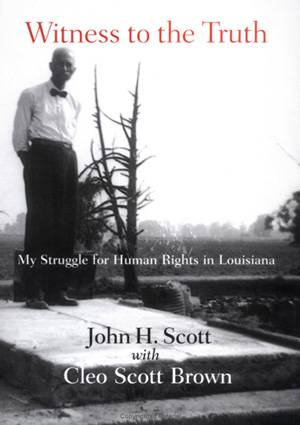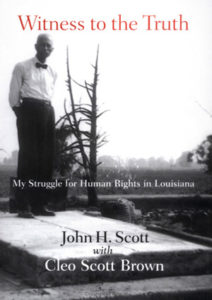Summer 2004
The Struggle for Equality in East Carroll Parish
A voting-rights activist tells his story of trial and triumph
Published: August 14, 2015
Last Updated: January 3, 2019

Scott was born December 30, 1901, in East Carroll Parish, Louisiana, near a Mississippi riverboat stop called Atherton. At age 3, he was sent to live with his grandmother, “a strict moralist” from whom he learned perseverance and the value of maintaining his dignity. He recounts: “I had always had this independent spirit — this need to be free and respected like a man. Other [people] always seemed to appreciate my taking a stand, although they were afraid to do it themselves … For some reason, I never had a chance to be brainwashed like many blacks who grew up in the early 1900s under a system of severe racism.”
Scott’s grandfather had been born free before Emancipation, then “bound out” as a latter-day indentured servant. He served in the Union army, enlisting in New York City in 1863. He then moved to Louisiana in 1872, persuaded by a labor agent to work one of the large plantations there. Once he arrived, Scott’s grandfather lived through the empty promises of Reconstruction: “In fifteen short years, black people went from slavery to high-level political offices to no right to vote to hanging from the trees, and it was more defeat than the human mind could bear.”
Although the institution of slavery was long past, Scott remembers that when the elderly African Americans of East Carroll Parish talked, “their stories would turn to recollections of slavery days.” He adds, “Of course anyone who lived long enough to see how black people were handled on the old-time chain gangs could about see what the old people were talking about in slavery.”
John Scott completed an eighth-grade education, which qualified him to teach in the black school system. He attended high school classes when he could, but pursued hunting and trapping for money, while also farming with his family. In mostly African American East Carroll Parish, Scott saw the importance of having people stick together in order to effect change. The gross inequity of the sharecropping system, which kept farmers misinformed, in debt, and bound to long-term contracts, was institutionalized slavery in another form.
Scott’s connection to his church is intriguing — he is hesitant to accept what he refers to as his “calling to the ministry.” He joined the church, but doesn’t say anything about preaching. As he puts it, “I figured you couldn’t control being called, but you could control whether or not you answered the call.” But Scott believes that he received a bit of divine guidance, noting: “I went on with my normal routine, pretending like I hadn’t heard God. Not long afterwards, I got low sick.” In years to come, Scott would become more comfortable with his role as preacher, especially with the political power and influence that it gave him. Nonetheless, Scott remained on the outside of church hierarchy for most of his life, preferring to visit churches as a guest preacher.
Scott is exceptionally good at casting himself as a hero and iconoclast. He’s told many of these stories time and again, apparently, so a reader can mostly forgive the repetition and the minor discrepancies in this intensely personal narrative. As with most oral biographies, there is no corroboration for the stories, so we take Scott at his word.
Scott worked with the NAACP in its early years. His links to the organization are difficult to follow, but he seems to have attended a number of state and national meetings, and notes that he “stayed in contact with the organization” throughout his life.
At the 1943 NAACP conference in Detroit, Scott saw the organization’s potential power, even though it was clear to him that change would be slow to come to the South. He became convinced that the African American churches could “do away with segregation in a year’s time,” but that radical change was not part of most churches’ missions.
By the 1940s, voter registration became the central focus of Scott’s political life. He notes that, “since 1922, not one black person had been allowed on the voting rolls in East Carroll Parish.” The 1898 Louisiana state constitution effectively barred blacks from voting. This, coupled with segregationist Jim Crow laws, kept blacks shut out of both politics and social discourse. In this atmosphere of antagonism, Scott worked with Daniel Byrd of the NAACP and others to help circumvent the cat-and-mouse strategies employed by the East Carroll Parish voter registrar.
Readers will share some of Scott’s deep frustration when they read about the subtle tricks played upon blacks wanting to register. Tactics as obvious as locking the office door and as devious as requiring a potential black voter to acquire the signatures of two white citizens were accepted practices in East Carroll Parish. Especially interesting is the role of the local “Citizens’ Councils,” whose efforts reduced the NAACP’s membership in Louisiana from 13,000 to 1,700 by the end of 1956.
At the 1960 Civil Rights Commission hearing in New Orleans, Scott was called as the first witness. (A transcript is included as an appendix.) By bringing in the federal authorities, the movement toward universal voter registration had become more “legitimized,” which resulted in a “local, organized reaction.” A boycott against local black cotton farmers was finally resolved in an out-of-court settlement by the United States Department of Justice, but it was clear to the movement’s leaders that the issue and its repercussions would not be easily resolved.
Finally, in 1962, the federal court ruled in favor of the East Carroll Parish plaintiffs: “It was the culmination of over twenty years of trying to register, twenty years of obstacles placed in our way.” The State of Louisiana attempted to enforce a restraining order, but the federal ruling was affirmed soon thereafter.
By the early 1960s, Scott reflects: “My commitment to stay [in East Carroll Parish] cost me, and I often wondered whether I could endure.” The first African Americans to register found flaming crosses in their yards, and for Scott, it resulted in an attempt on his life. He was shot while driving on a country road with his family, which is the incident that begins the book. The sloppy police investigation that followed further illustrates the cruel injustices Scott withstood.
To appeal to recalcitrant black congregations that were not in favor of voter registration, Scott describes his approach. In guest sermons, he referred to the Book of Life, saying “ ‘You won’t be known, your name won’t be called in heaven, unless you get your name on the book.’ Then … I’d talk about the earthly book down at the registration office. ‘If you don’t get your name on there, you won’t be counted. Your needs won’t be recognized.’ ” His tactics seem to have brought a few more registrants, but it would be the Voting Rights Act of 1965 that would bring major changes.
The passage of the Civil Rights Act in 1964, coupled with the Voting Rights Act, finally gave African Americans in East Carroll Parish a sense of equality. Elected officials who had ignored them were suddenly courting these newly enfranchised voters.
Although Scott died in 1980, he lived to see John Henry Scott Day celebrated in Lake Providence, “to honor the life and achievements of a man totally committed to his community.”
Scott is a compelling storyteller, and his role in shaping the lives of African-Americans in East Carroll Parish makes him an important figure. His accomplishments stand on their own merits. His family seems to prevail alongside him, although his wife and children appear on only a few pages of the narrative. Most readers will hope for more information about them, as it would provide a more complete view of Scott’s life.
The challenge of oral biography is turning a series of interviews into a cogent narrative — that’s a challenge that Cleo Scott Brown doesn’t completely meet. As a daughter, she was likely familiar (perhaps too familiar) with many of her father’s stories. A stronger editorial hand would have eliminated unnecessary repetition and created a tighter chronology. And although oral biographers aren’t “required” to look beyond the subject’s own experience, it would be helpful to include more background information that would make the book a more useful historical tool.
Scott’s voice is one of many that combined in a powerful, world-changing chorus, and readers can be grateful to Cleo Scott Brown for her part in bringing his story to the printed page.
——–
Thomas Uskali resides in New Orleans and writes book reviews for the Mobile (Alabama) Register. He teaches literature at Isidore Newman School.
